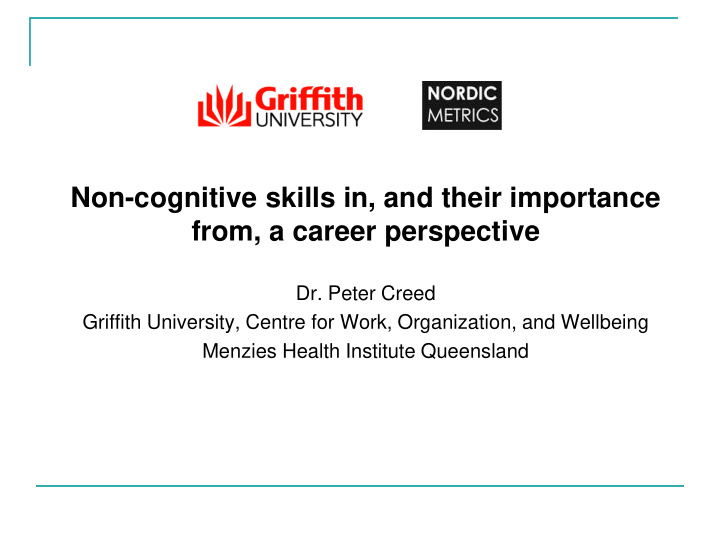



Non-cognitive skills in, and their importance from, a career perspective Dr. Peter Creed Griffith University, Centre for Work, Organization, and Wellbeing Menzies Health Institute Queensland
Non-cognitive skills in education (a) intrinsic motivation, self-efficacy, self-regulation, perseverance, conscientiousness, cooperation, resilience, attention, proactive behavior, critical thinking, empathy, creativity/openness, engagement, well-being, self-esteem, outcome expectations (b) “desired generic attributes”: employability, versatility, adaptability, engagement, global focus, life-long learning, critical thinking, problem solving, teamwork, communication skills, leadership readiness, intercultural competency, self-awareness, emotional IQ Making sense of how attributes develop and operate - what theoretical models help to explain how attributes develop and operate? - how do they fit together?
Theoretical Models (1) social cognitive theory (Bandura) and (2) goal-setting theory (Locke & Latham) - SCT (social), GS (work), control theory (health), reactance theory (child development)… - all goal-setting / self-regulatory Overview (a) social cognitive career theory (b) goal-setting theory (c) applications
SCCT Basic Choice Model - to explain decisions re Education/Work pathways (but think of decision-making generally; e.g., relationships) Self-efficacy Outcomes in Learning Choice Choices Interests domains of experiences actions (goals) interest Outcome expectations
. child exposed (directly/vicariously) to wide range of activities (e.g., in family, school, community) . child selectively reinforced Interests (e.g., parents, peers, teachers, themselves) . practice/exposure increase SE and OE for activity . enduring interests: view self as competent (SE) and expect valued outcomes (OE) Sources of self-efficacy and outcome expectations Choices - interests, SE, OE promote goal setting (goals)
Person, Contextual, and Experiential Factors affecting Choices Person Inputs -predispositions -gender Contextual Influences -ethnicity Proximal to choice behaviour -health status Self-efficacy Learning Outcomes in Choices Choice Interests experiences domains of (goals) actions interest Outcome expectations Background -opportunities -resources -barriers (Contextual affordances)
Person, Contextual, and Experiential Factors affecting Choices Person Inputs -conscientious -perseverance Contextual Influences -proactivity Proximal to choice behavior -critical thinking -wellbeing Self-efficacy Learning Outcomes in Choice Choices Interests experiences domains of actions (goals) -intrinsic mot -cooperation interest - self aware -engagement -leadership -employability Outcome expectations Background -self esteem -cultural competence (Contextual affordance)
Underlying Mechanisms for Decision-Making & Progress - in SCCT, goals drive behaviour (a) people set goals (or have goals set for them) (reflects “ideal” self) (b) people evaluate progress in relation to goal (have insight/get feedback on “actual” self) (c) determine discrepancy . if yes uncomfortable change behaviour, goals, or both - goal-progress discrepancies . main motivation for action (cognitions, behaviour; goal adjustment) self-regulatory processes
Sure of goal Defending Goal not so important Change Feedback Discrepancy Distress behaviour or goal Sensitivity self-regulation, self-awareness, co- operation, resilience, adaptability…
Applications . (career) identity development . job crafting . PTSD . advertising . etc
Theories potentially: - organise our thoughts - structure important variables - account for causal directions - alert you to non-obvious constructs and relationships - help explain why - provide parsimony (i.e., reduce clutter and chaos)
Thanks Any questions?
Recommend
More recommend